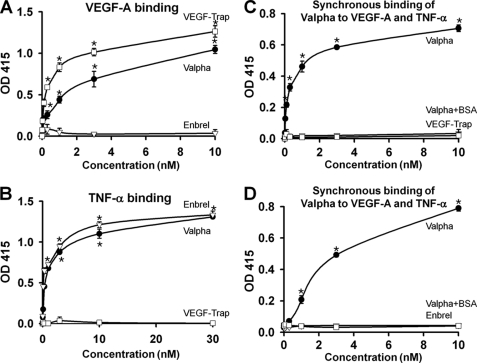FIGURE 2.
Valpha can simultaneously interact with both VEGF-A and TNF-α. The ability of Valpha to bind to VEGF-A and TNF-α was measured by ELISA. A, ELISA depicting the binding affinity for different concentrations (0.01–10 nm) of each indicated protein for VEGF-A. Values are given as means ± S.D. (n = 4). *, p < 0.05 versus Enbrel. B, ELISA depicting the binding affinity for different concentrations (0.03–30 nm) of each indicated protein for TNF-α. Values are given as means ± S.D. (n = 4). *, p < 0.05 versus VEGF-Trap. C, ELISA depicting simultaneous binding of Valpha to VEGF-A and TNF-α. 200 ng of TNF-α or BSA (negative control; Valpha+BSA) was coated on 96-well plates and blocked with 1% BSA in PBS. After washing, the indicated concentration of Valpha or VEGF-Trap was incubated and then washed. FLAG-tagged VEGF-A was added and captured with anti-FLAG M2 antibody. Values are given as means ± S.D. (n = 4). *, p < 0.05 versus VEGF-Trap. D, ELISA depicting simultaneous binding of Valpha to VEGF-A and TNF-α. 200 ng of VEGF-A or BSA (negative control; Valpha+BSA) was coated on 96-well plates and blocked with 1% BSA in PBS. After washing, the indicated concentration Valpha or Enbrel was incubated and then washed. His-tagged TNF-α was added and captured with HRP-conjugated anti-His tag antibody. Values are given as means ± S.D. (n = 4). *, p < 0.05 versus Enbrel.

